Intro
Chinese cuisine, with its rich history and diverse regional flavors, is a culinary adventure that has captivated food lovers around the world. From the bustling streets of Beijing to the remote villages of Tibet, each region offers a unique taste of China. In this blog, we’re taking you on a mouthwatering journey through the top 8 Chinese dishes that are sure to tantalize your taste buds and give you a glimpse into the heart of Chinese gastronomy.
Part 2: Top 8 Chinese Dishes to Savor
- Peking Roasted Duck
This iconic dish stands as a true emblem of Beijing, celebrated far and wide for its tantalizingly crispy skin and juicy, succulent meat. The preparation of this culinary masterpiece is an act of devotion, involving a meticulous process that includes marinating the duck to infuse it with rich flavors, followed by a careful air-drying phase to achieve the perfect texture. Finally, the duck is roasted to absolute perfection, ensuring that each bite is a harmonious blend of tenderness and delight. Traditionally, this dish is enjoyed by wrapping the succulent slices of duck in soft pancakes, adding a fresh touch of green onions, and a dollop of sweet bean sauce, creating an unparalleled culinary experience that is both satisfying and memorable.

Recommended Beijing Tour
- Hot Pot
Hot Pot, renowned for its peppery, spicy, fresh, and fragrant flavor, it has become a representative food not only in Sichuan but also in Chongqing. The history of Sichuan hotpot dates back to the Daoguang period of the Qing Dynasty (1821-1851), originating from the folk and later becoming a dish enjoyed in the imperial court. It is believed to have originated from the boatmen who lived along the Yangtze River, using a simple tile jar to cook various vegetables with hot pepper and Sichuan pepper to dispel dampness.
Chengdu Hot Pot is a social dining experience where a boiling pot is placed at the center of the table, accompanied by raw meats, seafood, and vegetables that diners cook themselves.The broth is the star of the show, with various options available to suit different tastes.
Traditionally, the broth is oily and spicy, made from either pork or beef and packed with Sichuan peppers, chilies, and red chili oil. Diners can choose their level of spiciness, from minimal to maximum. For those who prefer a milder experience, there are options like the Yuanyangguo, which offers a half-spicy and half-clear broth, the tomato hot pot, the mushroom hot pot, etc.
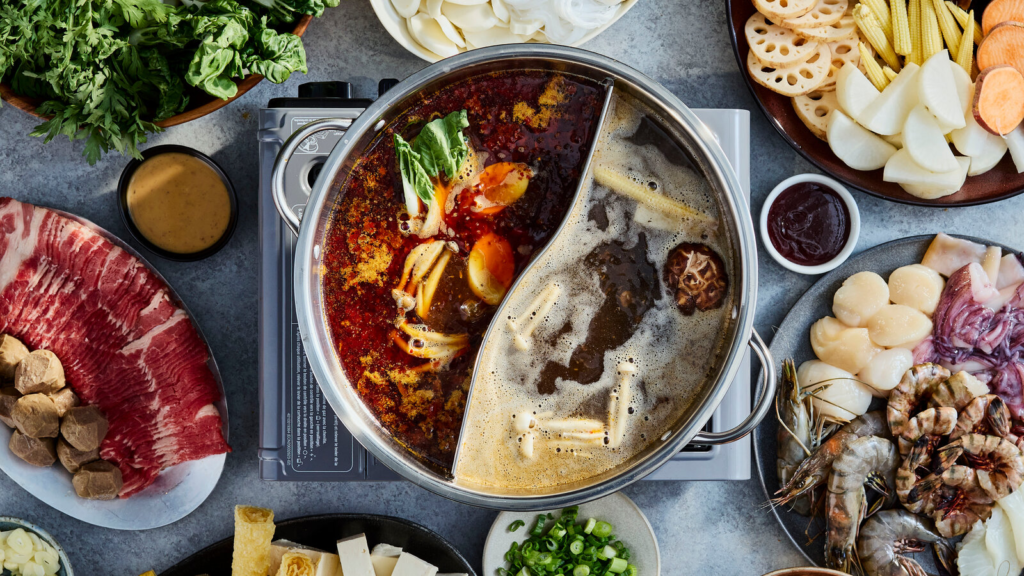
Recommended Chengdu Tour
- Dim Sum
Dim sum is a collection of small, bite-sized dishes traditionally served in teahouses for breakfast and lunch.Dim sum is known for its variety, with two broad categories: steamed and fried. Steamed dishes are typically served in bamboo baskets, and examples include char siu bao, a soft pork bun, and siu mai, which are cup-shaped rice-flour wrappers filled with pork, shrimp, and vegetables. Fried options are also popular, with the egg roll or spring roll being a staple, filled with minced meat and vegetables or, often, vegetables alone.
Some other most iconic dim sum dishes include:
Har Gow: Known as “shrimp’s bonnets” due to their characteristic ingredient and pleated shape, Har Gow are delicate dumplings with a thin, translucent skin that should be sturdy enough not to break when picked up with chopsticks.
Changfen: Commonly known as rice noodle rolls, Changfen is made from a thin strip of rice noodle, either plain or filled with shrimp, pork, beef, vegetables, and other ingredients. It is served with a warm, sweetened soy sauce poured over the top.

Recommended Guangzhou Tour
- Crossing the Bridge Noodles
Crossing the Bridge Noodles, known as in Chinese, is a traditional and highly distinctive local delicacy from Yunnan Province, China.
The dish is renowned for its rich and flavorful broth, which is typically served boiling hot in a large clay pot. The broth is the star of the show, often made from a slow-simmered chicken stock that is both fragrant and deeply flavorful.The unique characteristic of Crossing the Bridge Noodles is the variety of rich ingredients that accompany the broth. These include fresh meats such as thinly sliced chicken, beef, or pork, a variety of vegetables like greens, bean sprouts, lotus root slices, and eggs, as well as seasonal seafood. Each ingredient adds a unique flavor to the rice noodles, creating a symphony of tastes and textures.

Recommended Yunnan Tour
- Rou Jia Mo or Rougamo Bread
Rougamo Bread, is a traditional local snack from Shaanxi Province in China, with Xi’an Roujiamo being the most representative. The name Roujiamo translates to “a bun with meat in between,” and it is often referred to as the Chinese Hamburger. This dish features toasted buns with a crispy crust and soft interior, filled with tender and juicy meat.
There are different kinds of Roujiamo in Shaanxi, each with its unique characteristics. For instance, Tongguan Roujiamo is known for its special bun, called Qiancengbing, which means “pancake with a thousand layers,” offering a soft, multi-layered texture with each bite. Another variation is Saozi Roujiamo, which originated in Baoji, Shaanxi, and is made with a fried sauce of chopped pork and locally-made vinegar, offering a sour taste that neutralizes the greasiness of the meat.
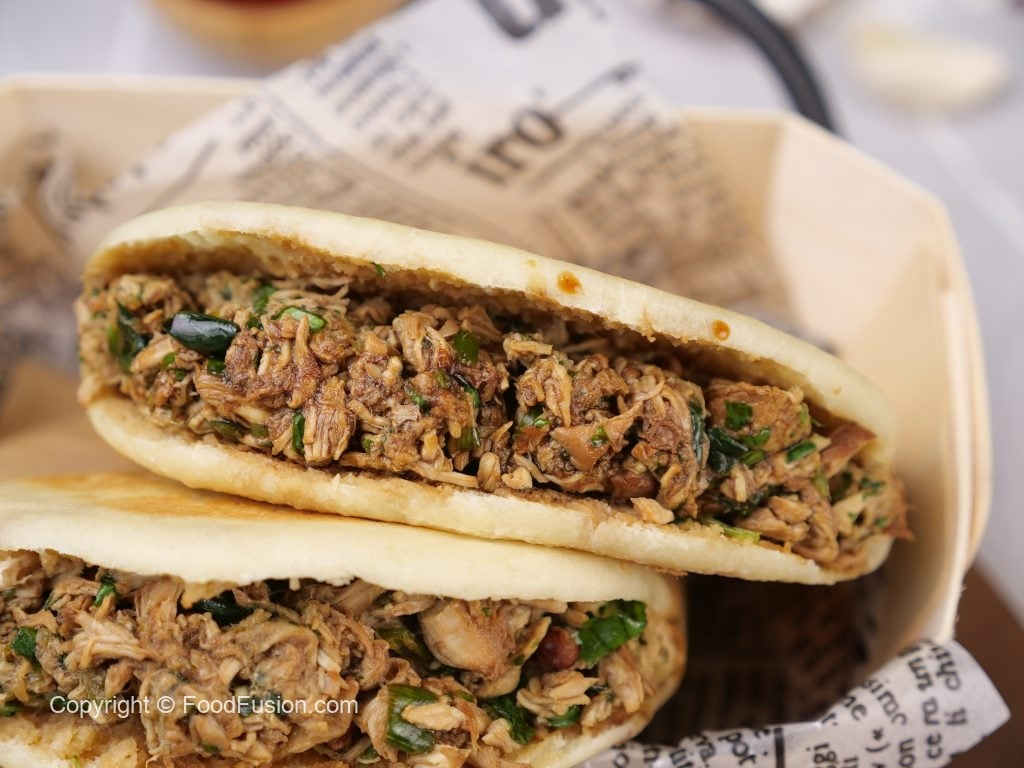
Recommended Xi’an Tour
- Beer-braised Fish
Beer-braised Fish, particularly famous as Yangshuo Beer Fish, is a delectable dish hailing from the beautiful town of Yangshuo in Guilin, China. At the heart of Beer-braised Fish is fresh river fish, traditionally carp or catfish, prized for their tender flesh and delicate flavor. The star liquid ingredient is local beer, such as Liquan Pijiu or Li River Spring Beer, which imparts a unique depth and freshness to the dish, thanks to the crystal-clear water from the Li River. The dish is further enriched with a medley of vegetables including tomatoes, green peppers, garlic, ginger, and onions.
Over the years, Yangshuo Beer Fish has transcended its humble beginnings, becoming a symbol of Yangshuo’s rich culinary heritage, embodying the spirit of innovation and tradition. Each family and restaurant has its own variation, passed down through generations.
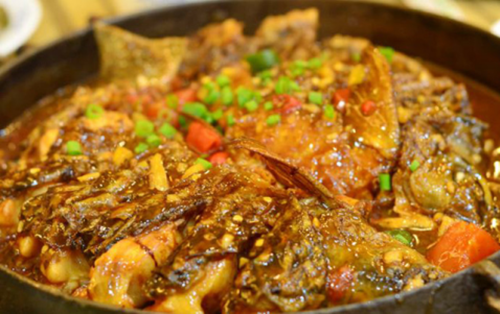
Recommended Guilin Tour
- Uyghur Polo / Pilaf
Uyghur Polo, also known as Pilaf, is a traditional rice dish that holds a significant place in Uyghur cuisine and culture. It is considered one of the most famous halal Muslim street foods in Central Asia and is often referred to as the “King of the Uyghur Table” .The dish is a unique combination of lamb, carrots, and rice, with the rice acquiring its flavorful color from the brown braised carrots and lamb. Polo is known for its slightly sweet taste and is often enjoyed with vinegary salads, such as Grilled Eggplant Salad, Vermicelli Salad, or Radish Salad. The preparation of Uyghur Polo involves browning the lamb in oil, followed by the addition of onions, cumin, salt, carrots, and sugar. The mixture is cooked for about 8-10 minutes before the rice is added.
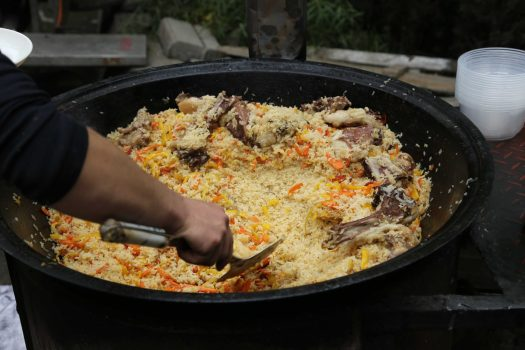
Recommended Xinjiang Tour
- Tibetan Yak Meat Hot Pot
Tibetan Yak Meat Hot Pot is a hearty and traditional dish that originates from the Tibetan Plateau, an area known for its harsh climate and unique culinary traditions. This dish is a testament to the region’s nomadic heritage and the importance of the yak in Tibetan culture, as it is one of the primary sources of food and warmth for the people living at high altitudes.
The broth is typically prepared with yak bones, which are simmered for hours to extract their rich flavors and nutrients. This process results in a broth that is both nourishing and flavorful, perfect for warming the body in the cold Tibetan climate. Alongside the yak meat, the hot pot often includes a variety of vegetables, such as potatoes, carrots, and leafy greens, which add texture and a touch of freshness to the meal.
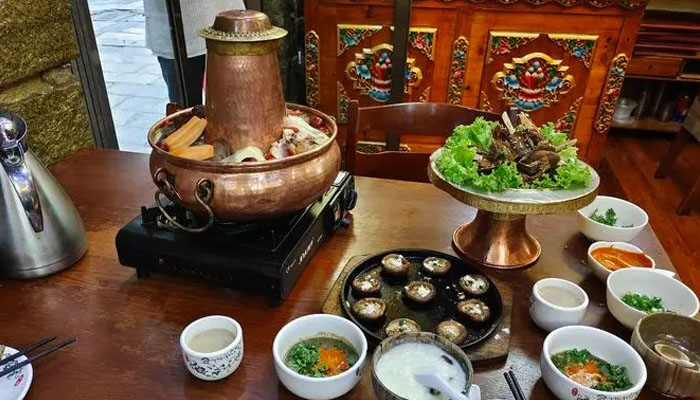
Recommended Tibet Tour





